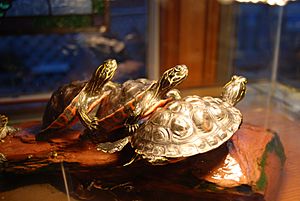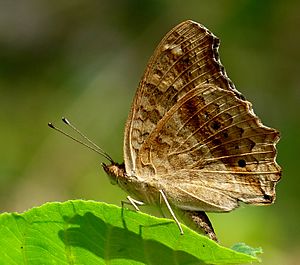Thermoregulation facts for kids
Thermoregulation is how living things, like animals and humans, keep their body temperature steady. They do this even when the temperature around them changes a lot. It's part of a bigger idea called homeostasis, which means keeping everything inside the body balanced and constant.
Contents
Warm-Blooded Animals: Endotherms
Animals often called warm-blooded are known as endotherms. These animals can control their body temperature to keep it quite high. All mammals and birds are endotherms. They create their own heat from the chemical reactions happening inside their bodies, which is called metabolism.
Endotherms have cool ways to control their temperature:
- When they get cold, they can do things to warm up. For example, they might shiver or shake. Shivering makes muscles move, and this movement creates heat. They might also run around or move to a warmer spot. This is why polar bears don't freeze; their bodies make heat, and moving around makes even more heat.
- Many warm-blooded animals have natural insulation. This means they have hair, feathers, or thick fat called blubber (like whales). These features help them keep the heat inside their bodies.
- When they get too warm, they can cool down. They might sweat, pant, or fluff up their feathers. They might also move to a cooler place and lie down to rest.
Hibernation and Aestivation
In places that get very cold, many mammals go into a deep sleep called hibernation. In very hot places, some animals do something similar called aestivation. During these times, their body temperature drops much lower than usual. This helps them save energy when there isn't enough food to keep their body temperature high. It's like having a low-power mode for their bodies!
How Humans Control Temperature
Your body has automatic ways to control its temperature.
- When you get hot, tiny blood vessels near your skin get wider. This sends more blood to the surface of your skin, allowing heat to escape more easily. This process is called vasodilation.
- Your sweat glands also make more sweat. When sweat evaporates from your skin, it takes heat with it, cooling you down. This is why you feel cooler after sweating on a hot day.
If your body gets too hot and can't cool down, it's called hyperthermia. This can be very dangerous. If your body temperature drops too low, it's called hypothermia. Both conditions can be serious.
Warm-Blooded Dinosaurs?
Scientists believe that some ancient animals, like pterosaurs (flying reptiles) and some smaller meat-eating dinosaurs, were also warm-blooded. We think this because pterosaurs had hair-like coverings. Also, some dinosaurs had feathers, even before birds could fly. Feathers likely first helped these dinosaurs stay warm, not fly.
Animals That Change: Heterotherms
Heterotherms are animals that can act like both warm-blooded and cold-blooded creatures. They can switch between different ways of controlling their temperature.
Body Size and Heat Loss
A key idea for animals is how they lose heat. Heat escapes from the surface of an animal's body, mostly through its skin.
- Think about it: a small animal has a lot of surface area compared to its body size. This means it loses heat much faster than a large animal.
- A big animal has less surface area compared to its body size. So, large animals lose heat more slowly. This makes them more "energy efficient" when it comes to staying warm.
How Small Animals Stay Warm
Small warm-blooded animals have clever ways to deal with losing heat quickly:
- They have a very fast metabolic rate. This means their bodies burn energy much faster than large animals. This rapid burning creates more heat. The smallest mammals, like shrews, and tiny hummingbirds have incredibly fast heartbeats and use a lot of energy.
- Many small animals let their body temperature drop at night. For example, many hummingbirds go into a deep, sleep-like state called torpor. In this state, their heart rate and body temperature drop a lot. This saves energy because they can't eat while sleeping.
- Almost all warm-blooded animals have insulation. Birds have feathers, and land mammals have fur. Marine mammals, like seals, have thick layers of fat under their skin for insulation in cold water.
- Some very large mammals, like elephants, have very little fur. Their challenge is actually getting rid of heat! Elephants use their large ears, which have many blood vessels, to cool down. They also like to wallow in water. Scientists think huge dinosaurs might have had similar problems staying cool.
Cold-Blooded Animals: Ectotherms
Ectotherms are often called "cold-blooded" animals. They usually get their heat from their surroundings. They need this outside heat to work properly, especially to digest their food.
Even though they are called cold-blooded, many ectotherms do things to keep their temperature higher than the air or water around them:
- Fast-swimming fish, like tunny and some sharks, can keep their bodies warmer than the surrounding water.
- Reptiles, such as lizards and snakes, will sit in the sun to warm up. When they get too hot, they move into the shade.
- Some insects, especially those living in groups, control their temperature. Termite mounds have special tunnels that allow air to flow through, like an air conditioning system. Honey bees fan their wings to cool their hive.
- However, many smaller invertebrates (animals without backbones) don't control their body temperature at all.
The scientific word for cold-blooded is poikilotherm (the animal itself) or poikilothermic (describing the animal).
- Schmidt-Nielsen, Knut 1972. How animals work. Cambridge University Press. ISBN: 0-521-09692-8.
Images for kids
-
Seeking shade is one method of cooling. Here sooty tern chicks are using a black-footed albatross chick for shade.
-
Simplified control circuit of human thermoregulation.
-
An ostrich can keep its body temperature relatively constant, even though the environment can be very hot during the day and cold at night.

See also
 In Spanish: Termorregulación para niños
In Spanish: Termorregulación para niños









